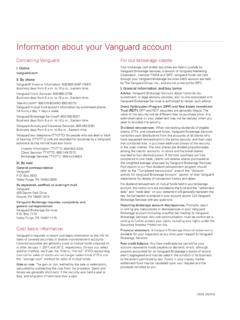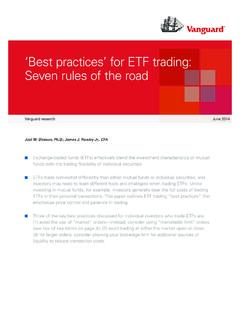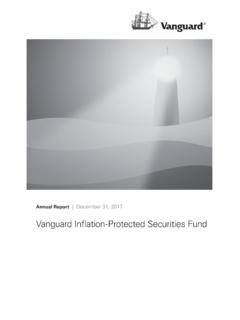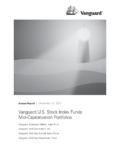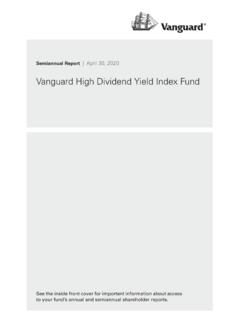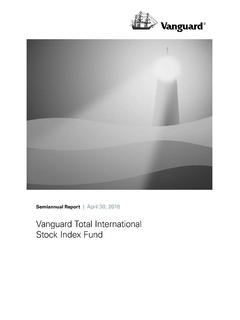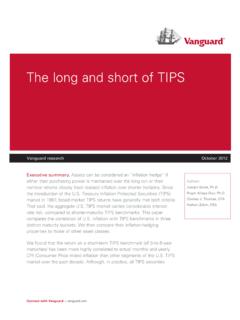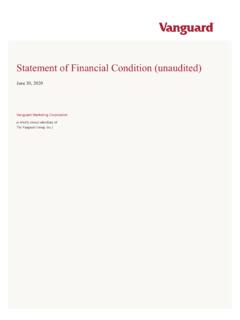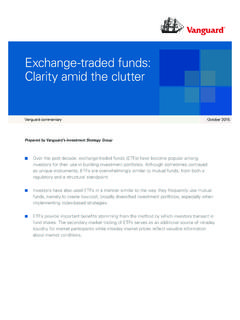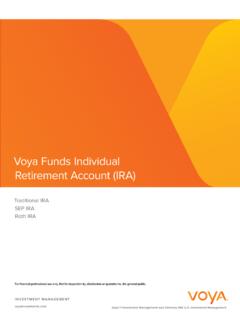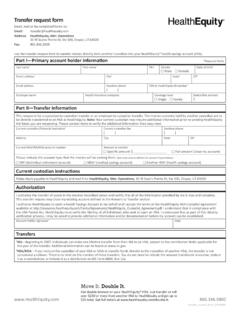Transcription of Important update for IRA owners - The Vanguard Group
1 2020 The Vanguard Group , Inc. All rights reserved. SECURE 012020 Important update for IRA ownersThe Setting Every Community Up for retirement Enhancement (SECURE) Act signed into law on December 20, 2019, includes several provisions that affect IRAs. Highlights IRA owners over age 70 can contribute to traditional IRAs. The age limit for contributing to a traditional IRA (including employee contributions to a SEP-IRA) has been eliminated. If you re still working, you may be able to contribute to your traditional IRA for 2020 and subsequent years, even after you reach age 70 (provided that you re otherwise eligible to make IRA contributions). IRA owners may be able to delay taking distributions until they reach age 72. If you turn 70 after December 31, 2019, the deadline for taking your first required minimum distribution (RMD) from your traditional IRA (including SEP and SIMPLE IRAs) is now April 1 of the year after the year you turn 72. (If you turned 70 prior to January 1, 2020, this rule change doesn t apply to you, and you must continue taking RMDs).
2 IRA owners younger than age 59 can take penalty-free distributions for the birth or adoption of a child. Beginning January 1, 2020, you can take a penalty-free distribution from your IRA (including traditional, Roth, SEP, and SIMPLE IRAs) up to $5,000 for the birth or adoption of a child. Such distributions must be made within one year from the date of the birth or adoption and can later be rolled back into an IRA. Special IRS reporting requirements apply. Nonspouse beneficiaries (with certain exceptions) must take RMDs within ten years. Nonspouse beneficiaries (with certain exceptions) who inherit IRAs (including traditional, Roth, SEP, and SIMPLE IRAs) from owners who die after December 31, 2019, must withdraw the entire IRA balance by the end of the tenth year after the IRA owner s death. A spouse beneficiary and certain nonspouse beneficiaries (including beneficiaries who are chronically ill or disabled, minor children of the IRA owner, beneficiaries not more than ten years younger than the IRA owner, and certain trusts) have the option to stretch RMDs over their own life expectancy or withdraw the entire account balance by the end of the tenth year after the IRA owner s death.
3 Please note that the Vanguard Traditional and Roth IRA custodial account Agreement and Disclosure Statement and the Vanguard SIMPLE IRA custodial account Agreement and Disclosure Statement don t yet reflect the changes in the law. We ll notify you of the changes and how to access the updated documents after they re amended to reflect the new moreFor more information about the SECURE Act and its effect on IRA owners and their beneficiaries, visit you have questions about how the new rules apply to your personal situation, we encourage you to consult a qualified tax advisor. Thank you for belonging to the Vanguard community of page is intentionally left blankThe Vanguard Traditional IRA, SEP-IRA, and Roth IRAD isclosure Statement and custodial account AgreementContentsVanguard Traditional and Roth IRA Disclosure StatementSection I Revocation ..1 Section II Establishment of your account ..1 Section III Contributions ..2 Section IV Transfers ..6 Section V Rollover contribution.
4 7 Section VI Conversions to a Roth IRA ..8 Section VII Taxation of distributions ..9 Section VIII Methods of distribution ..11 Section IX Simplified employee pension ..12 Section X Income tax returns ..13 Section XI Prohibited transactions ..13 Section XII Other information ..13 Vanguard Traditional and Roth IRA custodial account AgreementArticle I Definitions ..15 Article II Contributions to account ..16 Article III Investment of account ..17 Article IV Distribution of account ..18 Article V Transfers ..22 Article VI Reporting, disclosure, and fees ..23 Article VII Amendment, termination, and assignment ..23 Article VIII Miscellaneous ..24 1 Vanguard Traditional and Roth IRA Disclosure StatementIntroductionThis Disclosure Statement describes the general requirements and features of both a traditional and a Roth IRA, as well as the specific features of the Vanguard Traditional and Roth IRA custodial account Agreement . This Disclosure Statement is provided in accordance with Internal Revenue Service (IRS) regulations.
5 (Where the requirements for a traditional and a Roth IRA are the same, this Disclosure Statement refers to both types of accounts as an IRA . )Section IRevocationYou may revoke your Vanguard IRA at any time within seven days after it is established by mailing or delivering a written notice of revocation to Vanguard , P .O . Box 982901, El Paso, TX 79998-2901 . Any notice of revocation will be deemed mailed on the date of postmark (or if sent by certified or registered mail, the date of certification or registration) if it is deposited in the U .S . Postal Service in an envelope or other appropriate wrapper, first-class postage prepaid, properly addressed . Upon revocation, you will be entitled to a full refund of your entire IRA contribution without adjustment for administrative expenses, sales commissions (if any), or fluctuations in market value . If you have any questions concerning your right of revocation, please call 800-662-2739 during normal business hours.
6 Section IIEstablishment of your accountA. Statutory requirementsAn IRA is a trust or custodial account established for the exclusive benefit of you and your beneficiaries . The Internal Revenue Code of 1986, as amended, provides for several types of IRAs, including a traditional IRA and a Roth IRA . You must clearly designate on the forms establishing your IRA that your account is either a traditional IRA or a Roth IRA . An IRA must be created by a written document that meets all of the following requirements:1. Bank trustee or custodian. An IRA must be established with a qualified trustee or custodian, such as Vanguard Fiduciary Trust Company, which is a bank or other person approved by the IRS . You cannot be your own trustee or custodian .2. Cash contributions up to annual contribution limit. All contributions to your IRA, excluding rollover or conversion contributions as described in Sections V and VI, must be made in cash . The total amount of contributions, other than rollover or conversion contributions, for any taxable year to your traditional and Roth IRAs may not exceed the contribution limit in effect for such taxable year as described in Section III[A].
7 3. Nonforfeitability. The balance of your IRA account must be fully vested and nonforfeitable at all times .4. Prohibitions against life insurance and commingling. No part of your IRA assets may be invested in life insurance contracts, nor may your IRA assets be commingled with other property except in a common trust fund or common investment fund .5. Distribution rules. Your IRA must comply with certain minimum distribution requirements, which are described in Section VIII . (No age 70 distribution requirements apply for Roth IRAs .)B. Tax consequences of traditional IRAIn general, the federal income tax consequences of establishing a traditional IRA are the following:1. Tax-deferred earnings. Earnings and gains on your traditional IRA contributions will not be subject to federal income taxes until they are actually distributed .2. Deductible contributions. You may be permitted to make contributions to your traditional IRA that are deductible for federal income tax purposes in an amount up to the lesser of the contribution limit in effect for such year or 100% of your current-year compensation.
8 You are permitted to make deductible traditional IRA contributions if neither you nor your spouse is an active participant in an employer-maintained retirement plan, or if your adjusted gross income for the taxable year does not exceed certain dollar limits . To the extent that your traditional IRA contributions are not deductible, they may be treated as nondeductible contributions that must be reported on your federal income tax return . See Section III[D] for more information .3. Taxable distributions. Distributions from your traditional IRA will generally be taxable as ordinary income in the year of receipt, with the exception that if you have made any nondeductible contributions or after-tax rollover contributions to your traditional IRA, part of your traditional IRA distributions may be treated as a nontaxable return of your nondeductible traditional IRA contributions or after-tax rollover contributions . Any distributions you receive from your traditional IRA prior to age 59 may be subject to an additional 10% tax (although exceptions may apply see Section VII[C]).
9 You must start receiving certain minimum distributions from your traditional IRA beginning by April 1 of the year following the year in which you attain age 70 (see Section VIII[B]) .4. Tax-free rollovers. You may be eligible to make a rollover contribution to your traditional IRA of cash or other assets you receive from another individual retirement plan or employer-maintained retirement plan . In addition, you may be eligible to roll over the taxable amount you withdraw from your traditional IRA to another individual retirement plan or an employer-maintained retirement plan . See Sections V and VI for more information . 2 5. State taxes. The state tax consequences of your traditional IRA will vary from state to state . You are strongly encouraged to consult a tax advisor to determine the state tax consequences of establishing a traditional IRA .C. Tax consequences of a Roth IRAIn general, the federal income tax consequences of establishing a Roth IRA are the following:1.
10 Tax-deferred earnings. Earnings on contributions to a Roth IRA will accumulate on a tax-deferred basis and may ultimately be tax-free if the earnings are part of a qualified distribution . (A qualified distribution is generally a distribution made to you after age 59 and after you have held your Roth IRA account at least five years [see paragraph 3, below] .)2. Nondeductible contributions. Contributions to a Roth IRA are not deductible for federal income tax purposes .3. Qualified distributions are completely tax-free. A distribution from a Roth IRA will be tax-free for federal income tax purposes as long as it is a qualified distribution . A qualified distribution is a distribution from a Roth IRA: (1) made after a five-year holding period, and (2) made after age 59 , due to death or disability, or for the first $10,000 of qualified first-time home purchase expenses . See Section VII[B] for more details .4. Nonqualified distributions are tax- and penalty-free return of contributions first; taxable earnings last.
